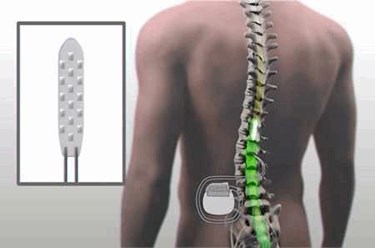Implanted Spinal Stimulation Device Restores Paralyzed Man's "Step-Like" Motions

Scientists from the Mayo Clinic have introduced new research in support of combining spinal cord stimulation (SCS) with physical therapy to restore movement for people paralyzed by injury. Two weeks after surgical implantation of a device near the injury site, a 26-year-old man — prepped with 22 weeks of therapy — was able to stand independently, intentionally move his legs, and make step-like motions.
The Mayo Clinic research was built upon a pilot study funded by the National Institute of Health (NIH) at the University of Louisville (UL) in 2009, in which a paralyzed man was able to stand and bear his own weight following SCS treatment. In 2014, a team, led by UL professor Claudia Angeli replicated the results in an additional four patients who were able to voluntarily flex their toes following (SCS) therapy.
Reggie Edgerton, a specialist in physical rehabilitation who was part of the research at UL and the inventor of the approach, led a study published in the Journal of Neurotrauma in 2015, which demonstrated success with non-invasive external stimulation from a transcutaneous electrical nerve stimulation (TENS) system in restoring voluntary movement for people with spinal cord injuries.
“This is a wake-up call for how we see motor complete spinal cord injury,” said Edgerton in a press release. “We don’t necessarily have to rely on regrowth of nerves in order to regain function. The fact that we observed this in all four patients suggest that this is actually a common phenomenon in patients with complete paralysis.”
Researchers from the Mayo Clinic, in conjunction with Edgerton’s team, are taking the technology a step further with an implanted SCS system and a rigorous physical therapy program. Researchers obtained approval from the FDA to investigate the use of existing implantable SCS technology for use in a patient with complete motor paralysis.
After 22 weeks of physical therapy to prep his muscles, a patient paralyzed for three years by a snowmobile accident was implanted with the device. Results of the study, which were published in Mayo Clinic Proceedings, demonstrated that the epidural electrical stimulation (EES) of the lumbosacral spinal cord enabled 26-year-old Jered Chinnock to regain some small control of his lower extremities.
“We’re really excited because our results went beyond our expectations,” said Kendall Lee, neurosurgeon at the Mayo Clinic and principle investigator of the study, in a press release. “These are initial findings, but the patient is continuing to make progress.”
Co-principle investigator Kristin Zhao, who is the director of the Mayo Clinic’s Assistive and Restorative Technology Laboratory, told Star Tribune that the team is interested in any motor function that can be restored to patients with paralysis.
“This has really set the tone for our post-surgical rehabilitation—trying to use that function the patient recovered to drive even more return of abilities,” said Zhao.
The Mayo Clinic recently announced a $70 million investment in infrastructure in Jacksonville, reported the Florida Times-Union. The Clinic plans to expand its spine center and pain rehabilitation programs, as well as cardiovascular programs.
